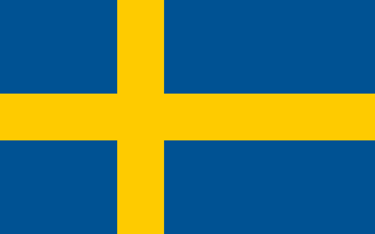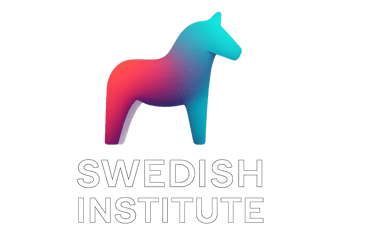SWEDISH COURSES
SATISFY YOUR THIRST FOR KNOWLEDGE
THE SWEDISH LANGUAGE: GATEWAY TO YOUR FUTURE
Welcome on behalf of the Swedish Institute!
If you wish to learn Swedish you are in right place. We have created the world's most Complete Swedish Master Course to take you from absolute beginner to native speaker in 30 days. In this section you will find all the information and answers you need about learning Swedish, such as: the best learning method, reasons to learn this language, the costs associated, the difficulty spikes to watch out for, how to improve your prior skills if you are stuck in a plateau, as well as the differences and similarities to other commonly spoken languages.
First of all, you should know that Swedish, known as "svenska" in its native form, is the official language of Sweden and one of the two official languages of Finland, where it is spoken by a significant minority along the western and southern coasts. Swedish is also understood in neighboring countries such as Norway and Denmark due to the high degree of mutual intelligibility among the Scandinavian languages. With about 10 million native speakers, Swedish is the largest of the North Germanic languages and serves as an important cultural and linguistic bridge in the Nordic region.

Swedish evolved from Old Norse, the language of the Vikings, which also gave rise to Danish, Norwegian, Icelandic, and Faroese. Over the centuries, Swedish developed its own distinct phonetic, grammatical, and lexical features, while still maintaining close connections with its Scandinavian cousins. Modern Swedish has been shaped by historical influences from Low German during the Hanseatic era, as well as from French, Latin, and English in more recent centuries. It’s distinctive features can be found in its Vocabulary, Grammar as well as its Pronunciation with its melodic intonation, clear vowel distinctions, and the characteristic use of pitch accent, which gives the language its sing-song quality.
The key to success lies in balance: daily bite-sized learning that fits your schedule, combined with structured progression that ensures you don’t just learn random words but actually build up real fluency step by step. You want modern audio so you can tune your ear to Swedish sounds, interactive exercises so you stay engaged, and clear explanations so you always understand why something works the way it does. Most importantly, you need consistency, because mastery in Hungarian—like in any language—comes from steady, rewarding progress over time.
If you are serious about learning Swedish, commit to a method that makes you actually speak the language. With the right system, you can go beyond memorised phrases and truly speak, read, and think in Swedish. The journey is demanding, but the rewards — access to Swedish literature, cinema, music, history, personal connections and work opportunities — are immense. If you want to really learn Swedish, the time to start is now, with our Complete Master Course that has been designed to give you nothing less than complete fluency.


NATURAL METHOD TO LEARN SWEDISH
Our language courses are based on the Natural Method, also known as the Natural Approach, developed by linguist Stephen Krashen and language educator Tracy Terrell. This approach focuses on creating an environment that mimics how individuals naturally acquire their first language, emphasizing comprehension, communication, and a stress-free learning experience.
While other language courses rely on rote memorization and drills, a heavy academic approach to grammar, repetitive exercises, expensive and time-consuming formal tutoring sessions or ineffective and shallow phone apps, we will have you gradually build your language skills like a child learning his/her mother tongue.
There are essentially 5 Core Principles in the Natural Method:
Comprehensible Input (i+1)
Learners acquire a language when they are exposed to materials slightly beyond their current level of understanding (represented as i+1). By hearing or reading content they mostly understand, learners can gradually internalize new vocabulary and grammar structures.Focus on Communication
The Natural Method prioritizes fluency and the ability to communicate over grammatical perfection. Errors are seen as a natural part of the learning process and are not heavily penalised, reducing anxiety and encouraging learners to express themselves.Emotional Element
Emotional factors like anxiety, motivation and enjoyment greatly influence language acquisition. When learners are in a relaxed state, achieved by removing the anxiety linked to the pressure to produce perfect grammar, it is easier for them to get through the initial phase which is arguably the hardest and where most give up. It is also proven to be easier for the brain to absorb and retain new information if the learner is actually interested in the language and its underlying culture, which is why he have included extensive cultural insights, historical and modern pop culture elements in our language course.Stages of Language Acquisition
Scholars have identified the following stages in the language acquisition process of young children:Pre-production: The "silent period," where learners focus on listening and understanding without speaking.
Early Production: Learners begin using simple words and phrases.
Speech Emergence: Learners can construct longer sentences and express ideas more freely.
Intermediate Fluency: Learners develop more complex language skills and can engage in meaningful conversations.
Advanced Fluency: Learners achieve near-native proficiency.
The goal of our courses is thus to mimic the natural language acquisition process without overwhelming the learner with long and tedious lessons but ensuring gradual gains so that he/she remains committed to his/her fluency goal.
Meaningful Interaction
Instead of rote memorization of single words and grammar rules over and over, the Natural Method encourages activities that involve real-world communication to help retain information. This is why we have included storytelling and role-playing scenarios that simulate everyday situations, with exercises that allow the learner to understand his/her current level and thus improve upon specific elements.




EXPAND YOUR KNOWLEDGE
If you are serious about learning Swedish, we recommend that you download the Complete Swedish Master Course.
You will receive all the information available on the website in a convenient portable digital format as well as additional contents: over 15.000 Vocabulary Words and Useful Phrases, in-depth explanations and exercises for all Grammar Rules, exclusive articles with Cultural Insights that you won't in any other textbook so you can amaze your Swedish friends thanks to your knowledge of their country and history.
With a one-time purchase you will also hours of Podcasts to Practice your Swedish listening skills as well as Dialogues with Exercises to achieve your own Master Certificate.
Start speaking Swedish today!
FREQUENTLY ASKED QUESTIONS
Top 5 reasons to learn the Swedish are:
It's Fun! Join a Unique Club
Swedish is a fascinating and melodious language that captivates learners with its smooth sounds, logical structure, and expressive vocabulary. As a North Germanic language, it offers an exciting opportunity to explore a system that is both familiar and refreshingly different for many learners. Spoken by about 10 million people worldwide, Swedish stands out as one of Europe’s most distinctive yet approachable languages. Learning Swedish feels like joining a special community—few non-Swedes achieve fluency, which makes it a truly rewarding and impressive accomplishment.Gain a Deeper Understanding of European History and Culture
Learning Swedish opens a window into a rich cultural and historical heritage that has shaped much of Northern Europe. Sweden’s history spans from the Viking Age and medieval kingdoms to its powerful era as a European empire and its modern role as a hub of innovation, design, and social progress. Through the Swedish language, learners gain deeper insight into Scandinavian traditions, literature, and the unique balance between modernity and nature that defines Swedish life. Understanding Swedish is not just about language—it’s about connecting with a culture that values equality, creativity, and harmony with the environment.Swedes Appreciate When You Speak Their Language
Swedes take great pride in their language, which reflects their cultural identity and values of clarity, modesty, and respect. Making the effort to speak even a few words of Swedish is warmly appreciated, as it shows genuine interest and openness. A friendly “Hej!” (Hello!) or “Tack så mycket!” (Thank you very much!) can make interactions more personal and pleasant. Whether in a small café in Stockholm or a village in Dalarna, speaking Swedish creates a bridge that turns formality into friendship.Business Opportunities in a Thriving Economy
Sweden has one of the most innovative and competitive economies in the world, with strong sectors in technology, renewable energy, healthcare, automotive design, and sustainability. It is home to global brands such as IKEA, Volvo, Spotify, and Ericsson, and offers a business environment rooted in transparency, collaboration, and trust. Learning Swedish can be a valuable advantage for professionals looking to build partnerships, work with Swedish companies, or establish a presence in the Nordic market. With its stable economy and commitment to green innovation, Sweden provides abundant opportunities for business growth and international cooperation.
Visit Sweden for an Unforgettable Experience
Sweden is an extraordinary destination, offering breathtaking landscapes, pristine lakes, and an enchanting mix of urban sophistication and untouched nature. Stockholm, built on fourteen islands, dazzles with its historic architecture and cutting-edge design, while Gothenburg and Malmö exude youthful energy and coastal charm. Beyond the cities, you can explore the magical forests of Småland, the serene archipelagos, and the stunning northern lights of Lapland. With its clean environment, safety, and welcoming people, Sweden promises an unforgettable travel experience that combines adventure, beauty, and tranquility.


Why learn Swedish?
How much does it cost to learn Swedish?
Swedish Mobile Apps
Mobile apps have become one of the most popular entry points for learning Hungarian in recent years, especially among young people, due to their accessibility on phones. These apps allow learners to repeat basic vocabulary on the go, through gamified systems that aim to keep learners engaged to sell them as many ads as possible. No one has ever really become fluent in Hungarian by using these apps but they can make daily studying more approachable, especially for people that are not completely sure if they want to commit to a more comprehensive language course.
Costs:
Many apps (e.g., Duolingo, Babbel, Pimsleur, Rosetta Stone) use paid monthly subscriptions averaging $20/month without ads or one life-time purchase for $200-$600.
Pros:
Self-paced content great for daily bite-sized repetition.
Fun language based games with flashy animations.
Good for absolute beginners to decide if interested.
Cons:
Quality and depth are overall quite low.
Subscription costs can accumulate quickly unless you opt for a lifetime deal.
Gamification makes it seem like you are progressing when you actually aren't.


Swedish Textbooks
Textbooks are a cost-effective and time tested resource for studying Swedish, or any language for that matter, just like when you were at school. Their adoption in academic settings has brought a lot of needless information into these books which on the contrary should be strictly practical. Textbooks offer a fixed progression with lots of grammatical terms and scholarly explanations that risks making the learning process feel like a chore. As with mobile apps, it is impossible to actually become fluent in the Swedish language with one single textbook, due to the lack of real life practice and interactivity, which is why even the most diligent learners only achieve a basic language level.
Costs:
Text-only textbooks cost around $20-$35 per volume. These usually include grammar explanations, vocabulary lists and exercises but do not provide any listening material. Textbooks with good quality accompanying audio resources are available for about $50-$60.
Pros:
One-time cost, no ongoing fees.
Textbooks with audio build solid grammar and listening comprehension.
Ideal for structured, self-paced study.
Cons:
Audio may be outdated or limited (if included at all).
Less interactive, needs self-discipline.
Might lack cultural/contextual immersion.




Studying Swedish at a University
University programs provide the most academically rigorous and comprehensive Hungarian training. You will become fluent if you attend the courses and get a degree. These courses require many years of commitment and are best suited for those pursuing careers directly connected to the knowledge of the Hungarian language like translators or teachers, which given the current state of the market might not be the wisest career choices, especially since you will be competing with native speakers that do not require any formal training to speak their mother tongue.
Costs:
Tuition for foreign students in Sweden is US $2,000–US $3,500/semester depending on the university. Monthly living expenses range from $700 to $1000, especially in cities like Stockholm. Rent for a shared student apartment can cost between $400 and $600 per month, while food and groceries average around $200–$300. Public transport passes for students are relatively inexpensive, typically $10–$15 per month. While tuition fees in Sweden are lower than in many Western European countries, the total yearly cost can range from €9,000 to €12,000, depending on location and lifestyle.
Pros:
Deep, structured academic immersion.
Degree qualification or recognized certifications.
Full immersion thanks to real Swedish speakers and situations that require language use.
Cons:
Time-intensive and long-term commitment with limited professional opportunities compared to other degrees.
Costs of living in Sweden add up quickly.
Difficult to find Swedish university courses outside of Sweden.


Online Swedish Courses
Online courses represent the most time and cost effective solution, with a personalised and immersive approach to language learning, thanks to structured lessons guided by professional teachers. When taken online these classes allow students to interact with their teachers in real time, providing opportunities for conversation practice, immediate feedback and progress tracking. Online courses come with three major downsides due to the extremely high costs of private tuition especially for beginners, varying teaching quality that depends on the individual teacher's experience and the fact that they don't allow the flexibility of other significantly cheaper self-study alternatives.
Costs:
Average Swedish 10-week course online with 3-5 live sessions costs US $600-$1,000/month
Private Tutors (available on Preply or Italki) cost US $10–$100 per hour, depending on the teacher’s qualifications
Pros:
Highly interactive with real-time feedback.
Customization, especially with one-on-one sessions.
Accountability and access to experienced teachers.
Cons:
Very expensive with no guarantee of success.
Lower flexibility compared to mobile apps or self-study since it depends on teacher's schedule.
Teaching quality may vary greatly between tutors.
How difficult is Swedish?
The Foreign Service Institute (FSI) of the United States Department of State classifies Swedish as a Category I language, meaning it is among the easiest languages for native English speakers to learn. This is due to its shared linguistic roots with English and its relatively straightforward grammar compared to many other European languages.
Several factors make learning Swedish more accessible for English speakers:
Familiar Vocabulary – As a Germanic language, Swedish shares a large number of cognates with English. Many words look and sound similar, making vocabulary acquisition faster and more intuitive. For example:
Bror (brother) – closely resembles “brother” in English
Glass (ice cream) – sounds like “glass” but has a different meaning
Hus (house) – identical in form and meaningStraightforward Grammar – Swedish grammar is simpler than that of many other European languages. There are no case endings like in German or Hungarian, and verbs do not change form depending on the subject. For instance, the verb att vara (to be) stays the same across all persons: jag är (I am), du är (you are), han är (he is).
Predictable Word Order – Swedish follows a consistent Subject-Verb-Object (SVO) structure, similar to English. While word order can vary slightly for emphasis, it remains largely predictable, making sentence construction easier for learners.
Pronunciation and Melody – Swedish is known for its melodic intonation, often described as “sing-songy.” Although pronunciation may seem challenging at first due to the pitch accent and unique vowel sounds, it quickly becomes natural with practice.
Our Swedish language course is designed to accelerate your progress, guiding you toward conversational fluency in just 30 days. Instead of overloading you with complex grammar from the start, our structured approach helps you build confidence gradually—focusing on communication, comprehension, and real-world usage from the very first lesson.


Why can't I improve in Swedish?
One of the biggest obstacles to learning Swedish isn’t necessarily the grammar—it’s the lack of comprehensive learning resources that effectively bridge the gap between beginner materials and advanced contents. Many learners find themselves stuck after reaching a beginner level because there aren’t enough books, courses, or accessible content. Unlike languages such as Japanese or Korean, where global pop culture (like anime or K-dramas) has created a huge international demand, Swedish media and culture have not spread worldwide in the same way. As a result, fewer people attempt to learn Swedish, leading to a smaller selection of textbooks, online courses, and language learning tools.
This lack of resources is further complicated by the fact that Swedish is not widely spoken outside Sweden, and the Swedish-speaking diaspora, while significant, is still relatively small compared to major world languages. While languages like Spanish or French have millions of speakers across multiple continents, Swedish is primarily concentrated in Sweden. This geographical limitation makes it harder for learners to find immersion opportunities, practice partners, and real-world language exposure.
We recognize that the lack of quality Swedish learning resources is a major challenge, and our goal is to bridge the gap by creating content that helps learners progress beyond the beginner level.
If you have any suggestions for future lessons or articles, feel free to send them to pr@swedish-institute.org — we’d love to hear from you and tailor our content to fit your learning needs!


Should I learn Swedish, Danish or Norwegian?
Choosing between Swedish, Danish, and Norwegian really depends on your goals, interests, and where you see yourself using the language.
Swedish is the largest of the three by number of speakers, with around 10 million people, mostly in Sweden but also in parts of Finland and global communities abroad. It boasts a rich literary and cinematic tradition, a strong cultural identity, and a clear, melodic pronunciation that many learners find appealing. While it still presents grammatical and phonetic challenges, Swedish is often considered one of the more approachable Scandinavian languages. Its wide usage and international visibility make it particularly practical if you want to connect with the greatest number of native speakers in the Nordic region.
Danish, spoken by about 6 million people, primarily in Denmark and Greenland, gives access to one of the world’s most progressive societies, known for design, architecture, and a high quality of life. Danish is also useful if you’re interested in working with international organizations or businesses based in Copenhagen, a city often ranked among the world’s most livable. Linguistically, Danish shares close ties with both Swedish and Norwegian, but its pronunciation can be difficult for learners. However, those who master it gain access to a distinct cultural landscape and strong connections across Scandinavia.
Norwegian, with about 5 million speakers, offers entry into a culture shaped by dramatic nature, literature, and a deep appreciation for the outdoors. It is often seen as the bridge between Danish and Swedish, since speakers of all three languages can generally understand each other. Norwegian’s grammar is relatively simple, and its consistent phonetic spelling makes it one of the easier Nordic languages to learn. It’s an excellent choice if you’re drawn to Norway’s cultural heritage, breathtaking landscapes, or the idea of working in a thriving, environmentally conscious society.
If your goal is to experience the perfect blend of cultural depth and real-world usefulness, Swedish stands out as the best choice. It offers access to the largest Scandinavian-speaking community, a rich literary and artistic tradition, and a language that serves as a bridge to understanding the entire Nordic region. Choosing Swedish means gaining a powerful tool for travel and work.


Is Swedish similar to other languages?
Swedish belongs to the North Germanic branch of the Indo-European language family, which also includes Danish, Norwegian, Icelandic, and Faroese. Being an Indo-European language, Swedish is closely related to English and German, sharing many grammatical features and vocabulary roots.
However, Swedish has also borrowed words from a variety of linguistic sources, throughout history, reflecting its role in trade, politics, and culture across Northern Europe:
Germanic languages (Low German, High German) – During the Hanseatic period and later through industrial and cultural exchange, Swedish adopted a large number of words from German, especially in trade, governance, and technology. English influence became dominant in the 20th century through science, media, and globalization.
Bank (bank) – from German Bank
Fönster (window) – from Low German vönster
Romance languages (French) – During the 17th and 18th centuries, when French culture dominated European diplomacy and art, Swedish incorporated many French terms in areas like cuisine, fashion, and the arts. Latin has also played a key role in scientific and ecclesiastical terminology.
Byrå (bureau, desk) – from French bureau
Parfym (perfume) – from French parfum
Doktor (doctor) – from Latin doctor
Slavic languages – Although less influential, some Slavic words entered Swedish through contact with Finland, Russia, and the Baltic region, especially in military and geographical contexts.
Torped (torpedo) – from Russian торпеда
Kosack (Cossack) – from Slavic kazak
Greek and Italian – As in most European languages, Greek and Italian contributed vocabulary in fields like science, medicine, and music.
Teater (theater) – from Greek theatron via French théâtre
Opera (opera) – from Italian opera
Today, Swedish continues to evolve under the influence of English, especially in technology, business, and popular culture. Words like app, streama (to stream), and dejta (to date) reflect the global reach of English while showing how easily Swedish integrates new terms into its flexible grammar and phonetic system.


How to become fluent in Swedish?
These are 5 proven methods that we have developed as language learners (not only as teachers!) that will help you achieve complete mastery of any language:
1. Immerse Yourself Completely
Surround Yourself: Change the language of your phone, computer, tv, console, news sources, radio stations, song playlists and streaming apps to the language you want to learn.
Engaging Content: Listen to native music, watch original movies, learn about the culture and history of the country on Youtube. This will help you stay motivated and reduce the initial frustration.
Make Mistakes: Travel to the country where the language is spoken and don't be afraid to engage with the locals. People will be amazed at your efforts to learn their language.
2. Focus on the Most Useful Words and Phrases
Study Efficiency: Learn the top 2,000 words in the language, as they often cover 80-90% of everyday conversations. Learning takes time but that doesn't mean it has to take very long to see results.
Real Conversations: Start by practising with common phrases you'll actually use in real-life situations, like greetings, ordering food, asking for directions, etc.
3. Use Memorization Techniques
Spaced Repetition: Our Courses are based on spaced spaced repetition systems (SRS) to help you memorize words and grammar in the long term and with miminal effort by showing them to you in progression.
Mnemonic Devices: trick your brain and speed up the learning process by trying to think of an example or "story" for each new word / expression you struggle to remember.
4. Learn the Language based on the Context
Practice Makes Perfect: Remember that your grammar doesn't have to be perfect as long as you can be understood! There is no shame in using simple phrases to get you point across.
Shadowing Technique: Repeat in your head after native speakers in real-time while listening or watching videos with original subtitles to improve your comprehension.
5. Consistency is Everything
Daily Practice: Even just 30 minutes a day is more effective than sporadic, long day study sessions. Take breaks often when reading and always have fun to increase productivity.
Compound Results: Small, achievable goals like reading 5 pages daily, or even just watching a movie or playing a videogame every evening produce results over time if you don't see them immediately.




EXPAND YOUR KNOWLEDGE
If you are serious about learning Swedish, we recommend that you download the Complete Swedish Master Course.
You will receive all the information available on the website in a convenient portable digital format as well as additional contents: over 15.000 Vocabulary Words and Useful Phrases, in-depth explanations and exercises for all Grammar Rules, exclusive articles with Cultural Insights that you won't in any other textbook so you can amaze your Swedish friends thanks to your knowledge of their country and history.
With a one-time purchase you will also hours of Podcasts to Practice your Swedish listening skills as well as Dialogues with Exercises to achieve your own Swedish Master Certificate.
Start speaking Swedish today!






